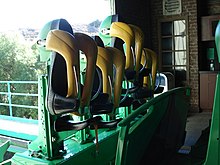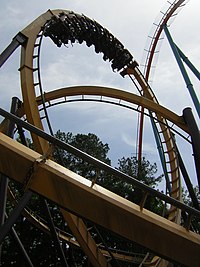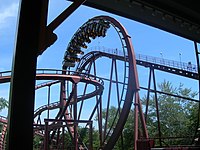
An inverted roller coaster is a type of steel roller coaster in which the train runs under the track with the seats directly attached to the wheel carriage. Riders are seated in open cars, letting their feet swing freely. The inverted coaster was pioneered by Swiss roller coaster manufacturer Bolliger & Mabillard in the early 1990s with the development of Batman: The Ride, which opened at Six Flags Great America on May 9, 1992.

Bolliger & Mabillard, officially Bolliger & Mabillard Consulting Engineers, Inc. and often abbreviated B&M, is a roller coaster design consultancy based in Monthey, Switzerland. The company was founded in 1988 by engineers Walter Bolliger and Claude Mabillard, both of whom had worked for Giovanola.

A Floorless Roller Coaster, is a type of steel roller coaster manufactured by Bolliger & Mabillard where riders sit with no floor underneath them, allowing their feet to swing freely just above the track. Development of the Floorless Coaster model began between 1995 and 1996 with Medusa at Six Flags Great Adventure opening on April 2, 1999, making it the world's first Floorless Roller Coaster. Floorless Roller Coasters also tend to have 3 to 7 inversions incorporated in the layout of the coaster.
Giovanola Frères SA was a prominent steel manufacturing company based in Monthey, Switzerland. It was known for building electrical power stations, water storage tanks, pipelines, boilers, highway bridges, submarines, ski lifts and many other steel products. The company started out as a small metal forging shop, founded by Joseph Giovanola in 1888. Joseph Sr. died in 1904, and the company was taken over by his sons, the eldest of which, Joseph Jr., was just 17 years of age. By 1930 the company had grown to the point that it required a new factory which was constructed in Monthey.

A hypercoaster is a roller coaster with a height or drop measuring at least 200 feet (61 m). The term was first coined by Arrow Dynamics and Cedar Point in 1989 with the opening of the world's first hypercoaster, Magnum XL-200, which features a height of 205 feet. The next hypercoaster, Pepsi Max Big One, opened five years later at Blackpool Pleasure Beach featuring a height of 213 feet (65 m).

Green Lantern, formerly known as Chang, was a stand-up roller coaster located at Six Flags Great Adventure in Jackson Township, New Jersey. Green Lantern stood 155 feet (47 m) tall and featured a top speed of 63 miles per hour (101 km/h). The 4,155-foot-long (1,266 m) ride featured five inversions and had a duration of approximately 21⁄2 minutes. The steel coaster was designed and built by Swiss manufacturer Bolliger & Mabillard.

The Riddler's Revenge is a steel stand-up roller coaster located at Six Flags Magic Mountain. Manufactured by Bolliger & Mabillard, the ride opened as the park's eleventh roller coaster on April 4, 1998, setting multiple world records among stand-up coasters. Originally located in the Movie District section of the park, which later became Metropolis in 2017, The Riddler's Revenge was also the park's single biggest investment at a cost of $14 million. It features a height of 156 feet (48 m), a maximum speed of 65 mph (105 km/h), six inversions, and a track length of 4,370 feet (1,330 m).

Nemesis Reborn, previously Nemesis, is an inverted roller coaster located at the Alton Towers theme park in Staffordshire, England. It was manufactured by Bolliger & Mabillard (B&M) and designed by Werner Stengel, from a concept by park developer John Wardley. It opened in the Forbidden Valley area of the park on 19 March 1994.
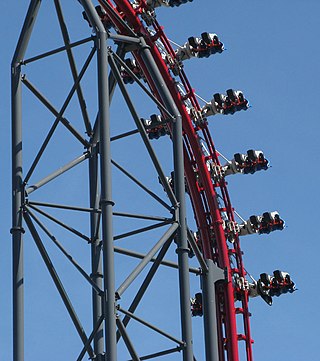
A fourth-dimension roller coaster is a type of steel roller coaster where riders are rotated independently of the track's orientation about a horizontal axis perpendicular to the track. This feature allows riders to experience inversions without the track rotating upside down. Some fourth-dimension roller coasters are controlled, with seats that rotate based on the spacing of two additional rails on the track. Others are free-spinning, where the seats flip primarily due to forces exerted by the ride's elements, offering a different experience during each ride.

The Pipeline Coaster is a roller coaster model where the trains ride between the tracks as opposed to a traditional roller coaster where they ride above them. The concept was first developed by Japanese ride company TOGO, and was known as the Ultra Twister. They built six installations of the design, and four are still in operation. Arrow Dynamics created an alternate version of the concept, but it never made it past the prototype stage in development. Intamin also experimented with the pipeline concept and built and relocated one model, known as the Spiral Coaster, but it is no longer operating. Some of the drawbacks of the design include the need for large, uncomfortable over-the-shoulder restraints as well as the obstruction of the riders' view by the enclosed pipe structure.
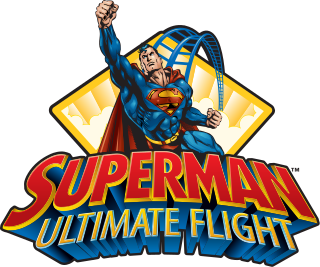
Superman: Ultimate Flight is the name of three flying roller coasters currently operating at three Six Flags amusement parks in the United States, those being Six Flags Over Georgia, Six Flags Great Adventure and Six Flags Great America. Each of these steel coasters were designed and built by Swiss manufacturer Bolliger & Mabillard and opened in 2002 and 2003. Since 2003, Six Flags has installed Superman: Ultimate Flight in three of their parks. Themed to the popular comic book character, Superman: Ultimate Flight simulates flying by positioning its passengers parallel to the track, supported by harnesses and facing the ground through most of the ride. In the station, riders board the train sitting down. After the train is locked and checked, the trains are raised into the flying position. After the ride, the seats are lowered back into the sitting position for the next round of riders.

TOGO was a Japanese amusement ride company that built roller coasters, giant wheels, carousels, flumes, dark rides, sky cycles and other amusement rides.

The Suspended Looping Coaster is a model of steel inverted roller coaster built by Dutch manufacturer Vekoma. There are at least 39 different installations across the world. The minimum rider height requirement is 130 centimetres. Vekoma is now marketing a Suspended Thrill Coaster as a successor to the Suspended Looping Coaster. The Odyssey is the largest, fastest and tallest SLC ever built at Fantasy Island in the UK.

Flashback was a steel roller coaster made by Intamin of Switzerland. The coaster was located in the Six Flags Plaza area of Six Flags Magic Mountain in Valencia, California. The model of the ride, a Space Diver coaster, was intended to be mass-produced, however, Flashback was the only installation.
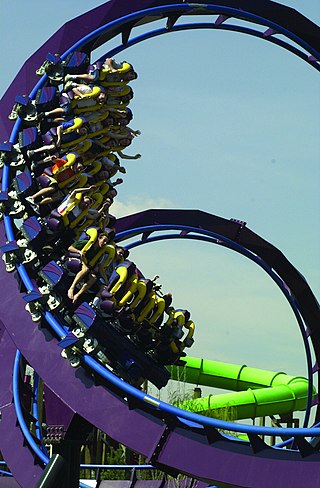
Batman: The Dark Knight is a steel floorless roller coaster designed by Bolliger & Mabillard located in the Gotham City section of Six Flags New England. The roller coaster has 2,600 feet (790 m) of track, reaches a maximum height of 117.8 feet (35.9 m) and features five inversions. The coaster was released to the public on April 20, 2002. In 2008, the ride's name was changed to Batman: The Ride to avoid confusion with Six Flags New England's installation of The Dark Knight Coaster that was planned to be built at the park, but after the project was cancelled, the ride's name reverted to Batman: The Dark Knight.

The Dive Coaster is a steel roller coaster model developed and engineered by Bolliger & Mabillard. The design features one or more near-vertical drops that are approximately 90 degrees, which provide a moment of free-falling for passengers. The experience is enhanced by unique trains that seat up to ten riders per row, spanning only two or three rows total. Unlike traditional train design, this distinguishing aspect gives all passengers virtually the same experience throughout the course of the ride. Another defining characteristic of Dive Coasters is the holding brake at the top of the lift hill that holds the train momentarily right as it enters the first drop, suspending some passengers with a view looking straight down and releasing suddenly moments later.

Chupacabra is an inverted roller coaster located at Six Flags Fiesta Texas in San Antonio, Texas, United States. Designed by Werner Stengel and Swiss manufacturer Bolliger & Mabillard, Chupacabra initially opened in 1995 at an amusement park in Japan, it then operated at Six Flags New Orleans until Hurricane Katrina caused the parks abandonment in 2005 and removal of Chupacabra and was relocated to Six Flags Fiesta Texas where it has operated since 2008. It stands at a height of 105 feet (32 m), reaches a maximum speed of 50 mph (80 km/h), and features multiple inversions.
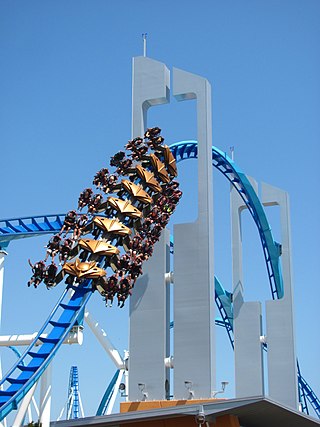
Wing Coaster is engineering firm Bolliger & Mabillard’s designation for its winged roller coaster designs. Winged roller coasters are a type of steel roller coaster where pairs of riders sit on either side of a roller coaster track in which nothing is above or below the riders. B&M began development on the first Wing Coaster between 2007 and 2008 leading to the opening of Raptor at Gardaland on 1 April 2011. There were eighteen B&M-designed Wing Coasters either under construction or operating worldwide as of 2024, with one more standing but not operating.

Sky Scrapper is a flying roller coaster at World Joyland in Wujin, Changzhou, Jiangsu, China. Sky Scrapper was one of World Joyland's opening day attractions, officially opening on April 30, 2011. The 2,805.1-foot-long (855.0 m) ride stands 131.3 feet (40.0 m) tall, and features a top speed of 54.7 mph (88.0 km/h). Designed by Swiss firm Bolliger & Mabillard, Sky Scrapper restrains riders in the prone position and features five inversions.

